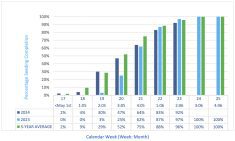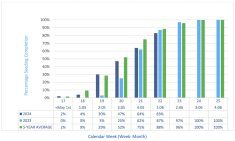Weekly Provincial Summary
Precipitation was variable across agro–Manitoba from June 12 to 18 with values ranging from 0 to 23.6 mm. Only the San Clara (23.6 mm) area in the Northwest received significant rainfall over the past seven days. Most other regions received less than 5 mm of rain. Total accumulated precipitation from May 1st to June 18th can be found below (Figure 1 above).
Soil Moisture 0 – 30 cm (Figure 2 above) shows a regional representation of soil moisture conditions for the top 30 cm on June 18, 2023 relative to field capacity. Soil moisture levels are variable throughout agro- Manitoba with the majority of the province showing optimal to dry to the 30cm depth. Some areas of the Central, Interlake, and Northwest regions are showing very dry conditions.
Read Also

Manitoba boosts stake in cereals centre to $23.5 million
Premier Wab Kinew said the additional project funds will help ‘Trump-proof’ the provincial economy.
Percent Normal Accumulated Growing Degree Days (May 1 – June 18), represents the variation of accumulated Growing Degree Days (GDD) from the historical record over a 30-year period. Continued warm temperatures has resulted in all of the agricultural regions in the province accumulating more than 125 per cent of normal GDD.
To find interactive soil temperature/moisture and air temperature information see Agri-Maps Current Weather viewer.
Overview
The biggest concern amongst crop producers remains the lack of significant rainfall. Sporadic showers across Manitoba over the last week made little contribution to crop moisture maintenance. Cereal crops are reported to be in the four leaf to full flag leaf stage. Crops have shown rapid development and remain in good condition except later planted fields with uneven and thin stands due to dry topsoil. Corn has advanced rapidly with the recent heat and most of the fields are at the V5 to V8 stage. Canola has advanced rapidly beyond its vulnerable growth stages in most regions except for later planted fields. Soybean development was rapid during the last week with the warm weather. Iron deficiency chlorosis has been observed in most regions. Hay and pasture growth has slowed and is showing signs of moisture stress. Hay yields will most likely be down from last year.
Cereals
Corn has advanced rapidly with the recent heat and most of the fields are at the V5 to V8 stage. Rain is needed to help it progress.
Spring cereal fields ranged from four leaf to full flag leaf. Crops have shown rapid development and remain in good condition except the later planted fields with uneven and thin stands due to dry topsoil.
Fall rye growth stage ranged from milk to soft dough. Winter wheat crops ranged from flowering to milk stage. Winter cereals remained in good to excellent condition.
Oilseeds
Canola ranged from two leaf to flowering on the earliest seeded fields. Producers continued to monitor fields for flea beetles but few fields received insecticide applications. Canola has advanced rapidly beyond its vulnerable growth stages. In lower rainfall areas, growers remained concerned about canola emergence and thin, uneven stands, particularly for later seeded crop.
Sunflower growth ranged from the V6 to V10 stage with the crop demonstrating rapid growth and good to excellent condition.
Most flax crops are at growth stage 5 (stem extension) and the crop is expected to advance rapidly given the growing conditions.
Pulses and Soybeans
The field pea crop ranged from the eighth node to early flower. Producers and agronomists are assessing the need for fungicide applications as field peas continued to advance rapidly in the warm temperatures. The crop remains in good to excellent condition but growers are concerned about adequate soil moisture supply for the crop going forward.
Soybean growth stage ranged from first to fifth trifoliate. Crop growth and development was rapid in the warm weather. Iron deficiency chlorosis has been observed in most regions.
Dry beans are at the first to third trifoliate stage. Overall, emergence across the province is acceptable. There are a few reports of producers spraying for cutworms.
Forages & Livestock
- Forages
Most livestock producers are reporting dry condtions, rain is needed. - Dairy producers have completed first cut and approximately 50 per cent of beef producers have begun haying.
- Hay yields are highly variable due to the patchy nature of thunderstorms and associated rainfall
experienced this spring. - Hay and pasture growth has slowed and is showing signs of moisture stress. Hay yields will most likely be down from last year.
- Projected second cut will be minimal without significant rain.
- Reports of alfalfa weevil, producers are considering the need to spray following first-cut.
- Grasshopper populations have increased in the Northwest region adding further stress to hay fields and pastures. Pesticides are being applied where warranted.
Livestock
- Cattle are out on pasture and grass conditions are mostly good.
- Fly pressure is strong this year and is contributing to issues with pink eye.
- Water tables are decreasing dramatically and dugouts are approximately 50 per cent full.
- Water supplies are in good condition in the Southwest region
Regional Comments
Southwest
Light showers in the Pipestone, Brandon, and Hamiota areas. A deficit is starting to show in areas which have not received rain since May. Many areas in the Southwest region require good rainfall. Above normal temperatures this past week are accelerating dry conditions. Temperatures were variable with hot and humid days and slightly cooler nights. Daytime temperatures reached 29 C, and the minimum nighttime temperature recorded was 3.8 C . Average temperatures ranged from 15.4 to 19 C.
Fall rye is headed and starting to fill. Winter wheat is in flag leaf to early heading and flowering, producers are getting ready for fungicide application. Spring cereal crops are progressing with early-seeded cereals in the flag leaf stage. There are some visible signs of heat stress and a combination of heat and herbicide stress in cereal crops.
Peas advanced quickly and are at the eight to ten node stage. No visible flowers yet, producers are preparing to start fungicide application. Many soybean crops are in the first to second trifoliate stage, most producers have completed the first application of herbicide.
Canola crops are cabbaging with early-seeded canola starting to bolt. Some reports of insecticide spraying for grasshopper infestation in canola fields.
Corn is advancing rapidly with the recent heat and most of the fields are at the V7 to V8 stage, however, rains are needed to help it progress. Sunflowers are at the V6 to V8 stage.
Grasshoppers are starting to become an issue in some areas but most reports are from producers on pasture and hay land. Root rot in peas is not visible this year likely due to drier growing conditions. Some reports of cutworm and armyworm in canola.
Northwest
Cooler temperatures were welcomed early in the week, but higher temperatures returned by weeks end. Some localized showers occurred over the weekend with the northwest side of the region receiving precipitation. San Clara received the most with 25 mm.
There are areas in the region that have received very little precipitation so far this season and the crops and pastures/hay fields there are showing the effects of lack of moisture. Alonsa sitting at 14 per cent of normal, while other areas on the eastern side remain below normal at approximately 30 per cent of normal.
Spring wheat is progressing nicely. Some environmental stress has been evident where young plants exposed to extreme heat, moisture or wind had yellowed. For the most part it appears to be outgrowing this, however some areas remain yellowed and stunted. In-crop herbicide continues where conditions allow.
Field peas are at V8 to V9 for the most part and are looking good. Evidence of field pea weevil notching has been found in Roblin and Swan Valley.
Soybeans are moving along nicely and are at approximately second to third trifoliate. First herbicide application is nearly complete.
Canola seeding wrapped up, as well as a few reseeds. The most advanced crops are cabbaging and looking good. The last seeded and reseeded canola are in the emergence stage. Flea beetle pressure has lessened as the crop stage advances. Herbicide application in canola continues as appropriate stages are reached.
Central
The past week was once again dry for most producers in the central region. Dry conditions are having visible impacts on crop and forage production. Many crops have been suffering from moisture stress, with cereals hit particularly hard. In some areas cereals are yellowing. Reports from the Carman region show very dry conditions especially on the lighter, sandier soil.
Salinity at field edges and low lying areas has been an issue, causing crop stunting and death. Saline patches appear to be moving further into fields.
Temperatures have been lower than in recent weeks and the winds lighter. This has allowed many farmers to catch up on herbicide applications. Most herbicide spraying is now complete, with plant growth regulator applications in full swing. Some farmers have observed some minor foliar diseases in cereals and are preparing to apply fungicide to protect the flag leaf in the coming days.
Grasshopper populations are building fast, with damage being observed at the edges of fields near ditches. Damage is most visible in cereal, soybean and sunflower fields. Some producers have begun to spray ditches and field margins. Cutworm populations remain high for some farmers, but flea beetle pressure has subsided for most farmers.
Most cereals are around the six leaf stage and tillering.The most stressed cereals have started to head out, especially on headlands. Some of the earlier planted canola is at the three leaf stage, but most are at the rosette stage, with some plants bolting. Soybeans planted in adequate moisture are mostly between the first and the fourth trifoliate. However, there have been issues with soybean emergence, especially in areas with lighter soil and fields tilled prior to seeding. In such fields soybean germination has been very patchy. Iron deficiency chlorosis has been observed by producers.
Corn progress varies greatly depending on soil moisture. In the driest fields corn is V4 to V6, with many fields having areas visibly showing moisture stress and associated nutrient deficiency symptoms, especially phosphorus purpling. Corn fields with more favorable moisture are undergoing row closure and are at V8 to V9.
Peas are at the eight to ten node stage and about a week away from flowering. Due to the reduced rainfall peas appear to be shorter than they were in 2022.
Dry beans are at the first to third trifoliate. Potato hilling is finished and irrigation has begun. Sunflowers are between V4 to V8. Flax is around stage five, stem extension.
Winter wheat is flowering and fall rye is in the early milk stage. There is some concern that spring applied nitrogen was not accessed by crops because of lack of rain.
Eastern
A few isolated showers did occur in localized areas but made little contribution to the maintenance of crop condition. The reporting period started out with above normal conditions but hot temperatures moderated down into the normal range from Wednesday to Friday. Over the weekend, temperatures began to climb again and returned to the hot and humid conditions as experienced in previous weeks. Soils are becoming drier and producers would appreciate significant and widespread rainfall to maintain crop condition and assist unevenly emerging fields with filling out plant stands. The biggest concern amongst crop producers remains the lack of significant rainfall.
Fall rye growth stage ranged from milk to soft dough over the last week. Winter wheat crops ranged from flowering to milk stage. Winter cereals remained in good to excellent condition.
Most spring cereal fields ranged from four leaf to full flag leaf. Across the region, herbicide applications on cereals were about 90% complete with late seeded fields remaining. Crops have shown rapid development and remain in good condition except in the case of later seeded fields with uneven and thin stands because of dry topsoil and the resulting poor emergence.
Corn growth stage ranged from V5 to V7 for the earliest seeded fields. Across the region, herbicide applications were about 90% complete with some corn rapidly advancing out of stage. The crop remained in good to excellent condition and demonstrated rapid growth in the warm weather.
Sunflower growth ranged from the V6 to V10 stage with the crop demonstrating rapid growth and good to excellent condition. Herbicide applications are mostly complete.
Canola ranged from two leaf to flowering on the earliest seeded fields. Growers continued to monitor fields for flea beetles but only a few fields received insecticide applications and the crop is rapidly advancing beyond its vulnerable growth stages. In lower rainfall areas, growers remained concerned about canola emergence and thin, uneven stands, particularly for later seeded crop, fields where significant pre-seeding tillage had been done and where seed had been broadcast and incorporated. Overall crop condition ranged from fair to good with about 50 per cent of acres receiving a first pass of herbicide.
Flax crops are at growth stage 5 (stem extension) and getting taller. Herbicide applications are complete. The crop remains in good condition.
Soybean growth stage ranged from unifoliate leaf to fifth trifoliate for the earliest seeded crop. Crop growth and development was rapid in the warm weather. Field yellowing on the earliest seeded/most advanced crop is now subsiding more with each day. With later seeded fields, producers remain concerned about topsoil moisture availability at seeding depth, particularly in those areas with lower overall rainfall accumulations.
The field pea crop ranged from the eighth node to early flower. Producers and agronomists are now assessing the need for fungicide applications as field peas continue to advance rapidly in the warm temperatures. The crop remains in good to excellent condition but growers are concerned about adequate soil moisture supply for the crop going forward.
Interlake
Scattered showers occured during the past week with variability in rainfall amounts across the Interlake region. Fisher Branch and Gimli have adequate moisture conditions while the majority of the Interlake area is very dry. Crops are suffering from lack of rain and stress is evident in cereal crops, with some losing their green colour. Most crops are under heat stress, some re-seeding on fields where multiple stresses have occurred affecting crops such as canola and soybeans.
Cutworms had limited infestations in both soybeans and canola on lighter textured soils, specifically peat lands which are pre-localized. Cutworm damage warranted spraying in areas North of Riverton on canola, wheat, oat and soybeans. Grasshopper populations are increasing across the North Interlake. Starting to see grasshoppers hatching in pastures and perennial grass crops. Lygus bugs numbers in most crops are very high, flea beetle pressure is minimum. There was some spraying for flea beetle but on the average very little.
Herbicide spraying is about 90 per cent complete. Weed pressure is low on dry soils. The hot weather continues to hamper spray timing and farmers are restricted to spray early mornings or late evenings. Herbicide spraying will continue throughout this week on soybean, canola, and late-seeded crops.
Wheat mostly ranges from the five to six leaf, to early flag leaf. Soybeans are at unifoliate stage to second trifoliate stage. Sunflowers are at V4 to V6.















